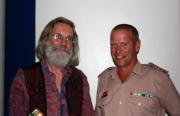
“Mountains are the most inspiring natural features on the planet. Artists, writers and mystics are all attracted to them as paramount places of spirituality, solitude and refuge. For centuries they have been barriers and borders for the organisation of society but they are increasingly becoming environmental havens,” Prof Goonie Marsh said.
Showing slides of different types of mountains from all over the world, he said that mountains are characterised by elevation and erosion, which gives them their dramatic shapes. Most mountains are formed by uplift as a result of the buoyancy of the crust, and are associated with plate boundaries where plates push against each other.
Prof Marsh has been a lecturer at the Rhodes Geology department for 38 years and presented a detailed talk entitled “Mountains: insights into the workings of Earth.”
“Mountains were first understood when layers of fossilised shells were discovered hundreds or thousands of metres above sea level, denoting that they were formed below the ocean’s surface. Mt Everest, for example, has a famous yellow band which contains fragments of marine animals,” said Prof Marsh.
In Southern Africa, there is unusually high elevation of up to 1000 metres, known as the African ‘super swell.’ Because there is no crustal shortening or folding, the consensus is that the mantle below Africa is warmer than average. This uplift has caused the Drakensburg and Lesotho highlands ranges, which is built of lava which erupted 180 million years ago.
Prof Marsh said: “Mountains give scientists perfect sections of lava flow- as it developed.” But basalt eruptions, which are accompanied by sulphur dioxide emissions, have an environmental impact. The sulphur dioxide combines with water to form sulphuric acid aerosols in the atmosphere. Luckily, sulphur dioxide only remains in the atmosphere for around 10 years so to produce dramatic, long-lived cooling eruptions need to be large to have an adverse affect.
“These eruptions, like those forming the Drakensberg, were very large and produced adverse environmental impacts, hence the idea that major mass extinctions seen in the fossil record may have been caused by volcanism,” he concluded.
For this year’s WESSA Wildlife Experience, WESSA Wildlife members have been exploring the mountains in the North-Eastern Cape highlands of Lesotho and attending talks and documentary screenings about the various aspects of these fascinating formations.
WESSA members were educated on mountain flora and fauna, rock art and early KhoiSan history as well as the palaeontology and geology of the beautiful mountain range in Tuschielaw, Lesotho.
To coincide with these events was an annual lecture at Eden Grove Blue lecture theatre, presented in honour of naturalist, scientist and historian, Jack Skead (1912- 2006), who received an honorary doctorate from Rhodes University in 1982.
Major Robin Collins spoke with tender devotion about his grandfather, who would have been 100 years old in April this year. “He gave me my first pair of binoculars,” he recalls. “He was 60 at the time so I guess he needed a fresh pair of eyes.”
Skead was particularly interested in the stone walls of the Albany district, which is currently being compiled into a study. “The way he saw things carried over to us, he made us inquisitive about how things worked,” said Major Collins.
The next WESSA outing will be to Nieu-Bethesda to look at the fossils of dinosaurs and reptiles.
Photo and story by Anna-Karien Otto
Photo: from l-r: Prof Goonie Marsh and Major Robin Collins, Skead's grandson.
